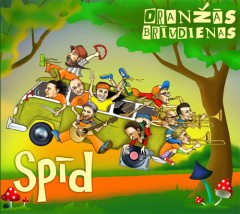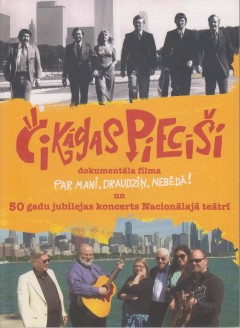As part of their 50th anniversary celebration in 2011, venerable American Latvian ensemble Čikāgas piecīši had a documentary film developed about them, entitled Par mani, draudziņ, nebēdā. Written and directed by Latvian filmmaker Igors Linga, the one hour documentary feature traces the group’s history from 1961 to their farewell (or, as guitarist/vocalist Armads Birkens says, their ‘first farewell’) tour in 2011.
The film, along with their farewell concert at the Latvian National Theatre on August 19, 2011, is now available on DVD (region 0, so it should play everywhere in the world). The film also has English subtitles.
The documentary film, like many Latvian documentaries, has no narration. It traces the history of the ensemble from its birth in 1961, to the present day through interviews with past and present members, interspersed with archival footage of the band performing, as well as home movies and pictures.
Alberts Legdziņš, the man who has been the leader and soul of the ensemble since its founding, provides a number of interesting details on the career of the group and how it all began (in fact, long-time member and bass player Uldis Streips notes that the group ‘existed’ prior to 1961 as well – Legzdiņš used to perform in their family’s basement). Legdziņš also notes the significance of late member Uldis Ievāns, who provided a lot of the material for their skits between songs. In fact, one time Ievāns and Legdziņš were arguing how to conclude a sketch, and even went on stage without knowing how it would end. What they wound up doing was simply walking off stage.
Long-time member and bass player Uldis Streips provides a lot of insightful commentary on the group, particularly the grueling travel the Piecīši had to endure – depart Chicago Friday night on the way to some Latvian center, drive all night, arrive in the morning, sleep a bit, perform, then drive to the next Latvian center Saturday night, perform Sunday, then drive back to Chicago Sunday night so that everyone could be back at their jobs on Monday mornings. Yet, even with this taxing schedule, the group was always able to entertain their audiences with energy and humor.
Par mani, draudziņ’, nebēdā makes it a point to acknowledge the significant role of women in the ensemble through the years, particularly Janīna Ankipāne (who brought a sort of American ‘folk singer’ style to a number of the group’s songs) as well as Laurie Wood (Lorija Vuda in Latvia), as well as a number of other women who have performed with them.
What makes the documentary particularly fascinating is the home video footage and the pictures from half a century ago, showing these young men playing, performing, relaxing, and horsing around. Also the interviews with former members such as Ilmārs Dzenis and Pēteris Strods provide additional perspectives on the early years of the group in the 1960s.
At about one hour, the documentary film does seem a bit brief, considering that there is fifty years of history to be covered, so certainly there is much more that could have been presented. A particularly glaring gap is their initial trip to Soviet Latvia in 1989 – though there are some clips and reminiscences about that tour, it would have been good to hear more about what made it possible. After all, it was just about the most remarkable event in the group’s history, something that, even a few years prior, would have been unthinkable. Also, it does seem that the film is not really meant as a straightforward historical documentary film, but more an overview of the group, their history, as well as their style and nature. The film expects its audience to already have some knowledge of the group, which may be fine for most, but for someone who had no idea of who Čikāgas piecīši were, it may not be in-depth enough for them to truly understand the significance of the group not just among exile Latvians, but all Latvians worldwide. Nevertheless, it is full of interesting facts and observations, made particularly worthwhile by the input of members both past and present.
The Čikāgas piecīši concert from the Latvian National Theatre is also on the DVD as a bonus. It is a particularly poignant event, considering that this is (probably) the last time the group will perform in Latvia.
The group, at the time of the performance featuring Alberts Legdziņš, Armands Birkens, Janīna Ankipāne, Lorija Vuda Cinkuss, Alnis Cers, Uldis Streips, Linda Maruta and Alberts Vītols, give a ninety minute performance that features their hits, as well as lesser-known songs from various eras.
A nice surprise is that the group, though certainly not eschewing their biggest hits, performs a number of songs which might not be as well known. A highlight is “Sabiedrības tiesā” (otherwise known as “What ze heck jūs gribiet”), with the obvious irony being that this song was written nearly fifty years ago when the group members were the younger generation, though now they are the older generation and have the same headaches with their children. Other highlights include “Vakardienas vīns”, with lead vocal performed by Alberts Vītols as well as the beautiful “Krāslaviņa” (with lyrics by the late Valdis Krāslavietis), particularly the lead vocal by Ankipāne with harmonies by Vuda and Maruta.
I find that the weakest section of a Čikāgas piecīši concert is when children are brought on stage to sing some of their songs. Though frightfully adorable, the artistic results do not usually match the cuteness of the children. Though it is a treat that the kids sing the less well known song “Skudru kāzas”, among other songs, the song may have sounded better with the ‘adults’ singing. Obviously one cannot expect the children to sing perfectly in harmony, but this section is rather slow.
The group is clearly slowing down and their performance schedule is not what it once was, meaning that perhaps rehearsal time is limited. What is particularly telling is that a number of the members have music stands in front of them, presumably with song lyrics and chords. There are a few shaky points over the course of the show, but the group’s ever-present charm more than makes up for these moments. Though, as with the documentary, showing this concert to someone who has no knowledge of Čikāgas piecīši might lead that person to wonder what all the fuss is about – what made these songs resonate with listeners both in exile and in Soviet Latvia?
As they approach the end of their career, Čikāgas piecīši remain one of the most significant Latvian music groups of all time. Par mani, draudziņ’, nebēdā! in both the documentary film, as well as the concert footage, provides a unique look at the group with interviews with many past and present members, as well as rare home video and photo footage. After fifty years of writing, recording and performing, Čikāgas piecīši are, without a doubt, a Latvian legend, and this DVD release is yet another testament to their talents and significance.
Details
Par mani, draudziņ, nebēdā DVD
Čikāgas piecīši
Rīga: Mūzikas video kanāls un Jura Podnieka studija, 2011
Egils Kaljo is an American-born Latvian from the New York area . Kaljo began listening to Latvian music as soon as he was able to put a record on a record player, and still has old Bellacord 78 rpm records lying around somewhere.






